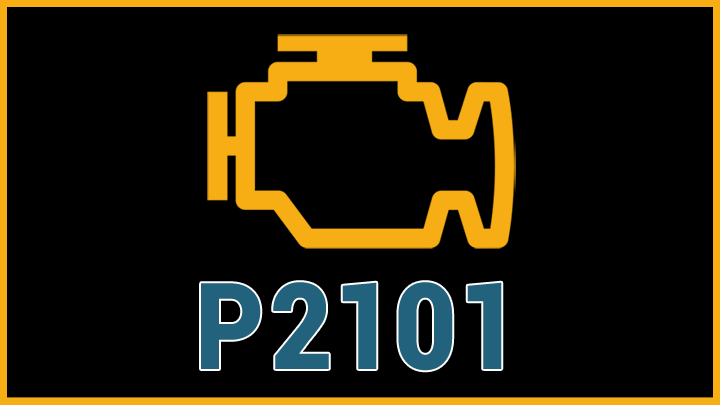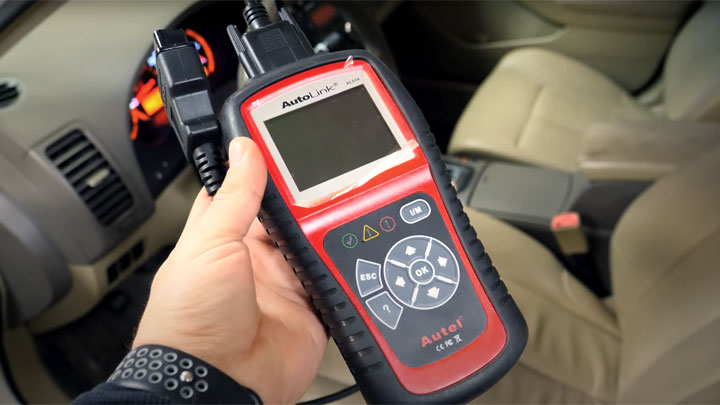P2101 Code (Symptoms, Causes, and How to Fix)
Nobody wants to see a check engine light on the dashboard when they start their vehicle, but with a code P2101, you’ll experience that and a drop in power.
The good news is that while this is an extremely frustrating and serious check engine code, it can be one of the least expensive check engine lights out there. Here’s what causes a P2101 code and how to fix it.

What Does Code P2101 Mean?
Your vehicle uses a sensor on the accelerator pedal to communicate with the Powertrain Control Module (PCM) what you want, and the PCM uses this data to tell the throttle how much to open. The throttle uses a sensor to measure how far it opens and sends this information back to the PCM.
If the measurement from the throttle position sensor doesn’t match what the PCM requests after getting the signal from the accelerator pedal position (APP) sensor, the vehicle will give off a code P2101.
What is the Throttle Actuator Control System?
The Throttle Actuator Control (TAC) system, also known as the electronic throttle control system, is a major part of your vehicle’s engine control. It manages the throttle control, which adjusts the amount of air flowing to the engine, affecting its power output and efficiency.
The TAC system is composed of the throttle actuator, TAC motor, and other related components and sensors.
When your car’s ECM (or PCM) communicates with the TAC, it sends a TAC signal to control the throttle actuator, adjusting the air intake as needed. The throttle actuator position performance is crucial in ensuring a smooth and efficient operation of the engine.
Symptoms of Code P2101
If your vehicle has a code P2101, you will notice a significant drop in performance. When everything is working the way it should, your vehicle will enter a type of “limp” mode. When this happens, it significantly impacts the level of performance.
Even if the vehicle doesn’t enter an official “limp” mode, you should notice a significant drop in performance. If you don’t notice a dip in performance and have a code P2101, something isn’t working the way it should, and your vehicle could accelerate rapidly or fail to accelerate when you want it to.
- Decreased engine performance
- Vehicles may enter limp mode
Causes of Code P2101

While the reason behind a code P2101 is pretty straightforward, there are several different potential causes for it. The most likely cause for a P2101 is a failed accelerator pedal position assembly. This is the sensor behind the accelerator pedal itself.
However, while this is the most common cause of a P2101, it’s not the only one. The issue could be with the PCM, or there could be a defective control motor.
Additionally, even if all these components are working the way they should, it won’t matter if the wiring is defective. There could be corrosion in the wires, crossed wires, loose connections, or a full-blown short.
Finally, if there’s something keeping the throttle from opening up to the correct position, this could be the problem too. While it’s unlikely, it could be corrosion keeping the throttle from moving as it should.
- Accelerator Pedal Position (APP) assembly failure
- Defective Powertrain Control Module (PCM)
- Defective control motor failure
- Wiring issues
Is Code P2101 Serious?
Yes. Not only is a code P2101 extremely serious, but often a code P2101 will force a vehicle into “limp” mode. When this happens, the vehicle limits the maximum power output it can produce, ensuring the vehicle doesn’t quickly accelerate.
While this helps keep the vehicle from accelerating uncontrollably, it also ensures the vehicle can’t get up to most speed limits. It’s enough to get you across a parking lot or through the neighborhood, but if you need to go onto a road with more vehicles, it’s not a good idea.
This means that if your vehicle has a code P2101, you’ll either need a mechanic to come to your vehicle or you’ll need to tow it to the shop to get it there safely.
How to Fix

If your vehicle has a code P2101, the most important thing you need to figure out is how to get it back on the road. While you could rush out and take the vehicle to a mechanic, nothing is stopping you from trying to figure it out on your own first.
If you have an OBD2 scanner, this is the perfect opportunity to break it out and check out the sensor readings from the throttle position sensor and the accelerator pedal position sensor when you depress the accelerator pedal to different amounts.
If the accelerator pedal position sensor adjusts to the right amount but the throttle position sensor doesn’t, you know the issue is likely in the engine bay, and if the opposite is true, the problem is likely behind the accelerator pedal.
If you don’t have an automotive scan tool, you can rule out the throttle position sensor and the accelerator pedal position sensor with a multimeter by checking the resistance levels and ensuring they are all within normal operating range.
You should also check for power at both sensors before moving on to everything else. If all the voltage and resistance readings check out, you likely have a problem with the wiring or PCM, but either way, it’s more challenging to diagnose either of these issues.
By far, the most likely reason for this code is a failed accelerator pedal position sensor, but we highly recommend verifying that this is the issue before swapping out the part.
- P0521 Code (Symptoms, Causes, How to Fix) - Mar 22, 2024
- How to PROPERLY Clean 5 Types of Steering Wheel Materials - Feb 19, 2024
- What Should You Do If Your Check Engine Light Comes On? - Nov 6, 2023
